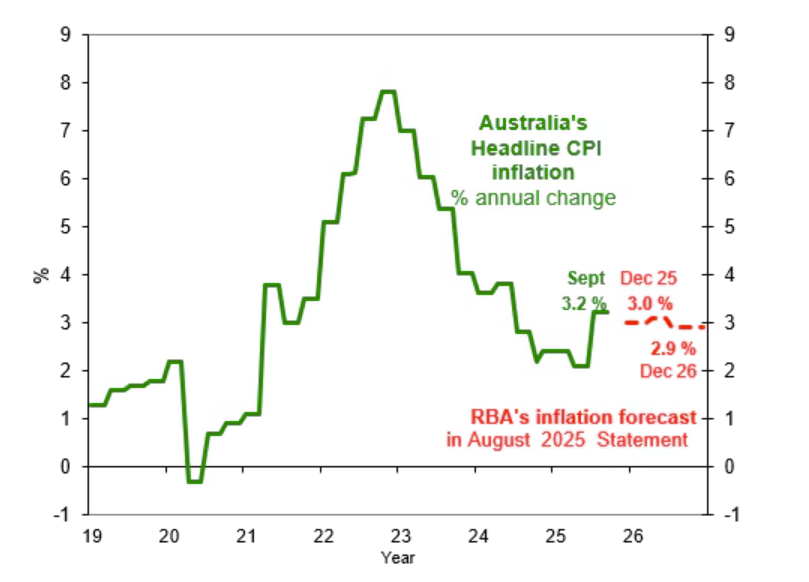Australia’s inflation remains a concern, but there’s still hope
After the peak of 7.8% in December 2022, Australia’s consumer inflation had been grinding downwards. However, the recent inflation result has proven to be a disappointment. Australia’s consumer inflation rate has come in at 3.2% in the year to September 2025 (Chart 1). Given that this is above the Reserve Bank of Australia’s (RBA) 2% to 3% target range for inflation, both consumers and investors are worried whether inflation is again a threat.
Chart 1: Australian consumer inflation

Sources: Australian Bureau of Statistics and Reserve Bank of Australia.
Why is the RBA forecasting that inflation will stay near 3% for the next year?
For the central bank, stubborn inflation around 3% is not a shock. The RBA’s judgement in August was that the Federal and state governments’ various electricity rebate measures are only temporary and that inflation would climb back to 3%.
“The extension of the Energy Bill Relief Fund is due to expire by the end of 2025, which will see year-ended inflation around 3 per cent through most of 2026.”1
The RBA’s judgement has been vindicated by the sharp 9% rise in electricity prices in the September 2025 quarter. This brings the annual rise in electricity prices to 23.6% (Chart 2).
The “cost of living” is also being experienced with other “essentials”
There have been more persistent price pressures in health care and insurance that remain troubling for consumers as well as the central bank. These consumer prices have been rising sharply over the past four years. In the year to September 2025, hospital and medical costs increased by 5.1%. Given Australia’s ageing population with more complex health needs, there seems to be limited prospects for medical costs being contained.
Chart 2: Australia’s troubling price pressures

Source: Australian Bureau of Statistics.
For car and housing insurance, a profound lack of competition has seen consumers squeezed by rising premiums. Indeed, in the period since March 2020 when the Pandemic started, insurance costs have risen by 46% compared to broader consumer price rises of 23%. Essentially insurance inflation has been ‘double trouble’ for consumers. However, there are early signs that insurance inflation is finally moderating with the recent annual increase of 2.6% well below the 14% peak inflation in 2024.
Australia’s inflation should moderate rather than accelerate higher over the next year
Given the angst over the September’s higher inflation result, there is still hope for lower inflation next year. MLC’s inflation gauge suggests Australia’s inflation pressures are more timid than threatening (Chart 3). This inflation gauge takes into account a range of fundamental factors such as global commodity prices, Australia's economic activity and cost measures to forecast future inflation.
Chart 3: Australia’s inflation pressures appear more timid than threatening

Source: Australian Bureau of Statistics.
Firstly, one needs to be humble about this inflation gauge. Inflation is impossible to precisely forecast. The former head of the US central bank Dr Ben Bernanke has noted that “Modern economies are complex and ever-changing, and they are subject to unpredictable shocks.”2 The sharp rise in Australian and global inflation in 2021-2022 after the Pandemic and Russia’s invasion of Ukraine is a timely warning of how dramatically and rapidly price pressures can emerge and persist.
Allowing for the fact that this inflation gauge is not a perfect forecasting measure, there is evidence to suggest that Australia’s inflation should moderate over the coming year. Australia’s current subdued economic activity should keep price pressures in check. In recent months, there has been a slowdown in household spending as well as job creation. Australia’s unemployment rate has risen by 0.5% to 4.5% in the past year to September which indicates that the job market is soft rather than strong. Hence instead of the solid revival in Australia’s economic activity forecast by the Federal Government and RBA, the reality is that the Australian economic activity is currently subdued. Further upside risks to inflation beyond the September quarter should be limited by this subdued economic activity.
The RBA has cut the cash interest rates three times this year in February, May and August. The current high inflation should caution the central bank against cutting interest rates again this year. Yet provided Australian price pressures moderate as suggested by the inflation gauge; there is still hope that the RBA will be contemplating lower interest rates again next year.
Stay informed
Our insights aim to keep you up to speed with issues driving the world’s investment markets. Get the latest thinking from our fund managers, and see what’s happening at MLC Asset Management. Find out more here.

